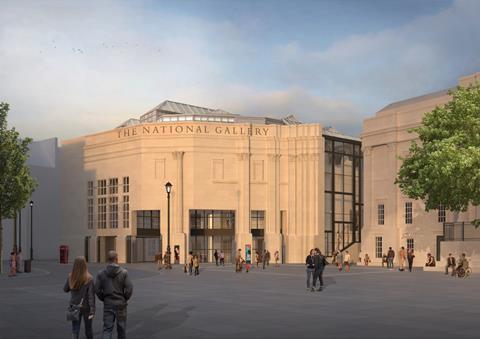Proposal has been attacked by eight former RIBA presidents
Selldorf’s revised plans to remodel the National Gallery’s grade I-listed Sainsbury wing are set to be given the green light next week despite eight former RIBA presidents calling the designs “even more ill-judged” than the previous proposals.
Westminster council’s planning officer has recommended the highly controversial application for approval at a meeting due to take place on 29 November.
It will see major alterations to the 1991 Venturi Scott Brown & Associates-designed building in order to increase visitor capacity, including removing a large section of floorplate, cladding pillars in sandstone and relocating a group of Egyptian-style columns.

The officer’s report admitted the plans would cause harm to the heritage of the building but concluded that this would be outweighed by “significant and weighty” public benefits.
These included the creation of a more welcoming environment for visitors through increased space and natural light, easier operation for security services and improved energy performance.
But the former RIBA presidents said the plans looked as if Selldorf “is trying to jam a modern building into the guts of the Sainsbury Wing and wholly change its character”.
Paul Hyett, Sunand Prasad, Ruth Reed, Angela Brady, Stephen Hodder, Jane Duncan, Ben Derbyshire, and Alan Jones said in a letter to the council that the plans would change a “finely conceived space into an airport lounge”.
Historic England have taken a different view and appear to have shifted their position on the scheme in light of the revisions, having said in a consultation on the former version of the proposals that they would harm the building’s heritage.
In a second consultation, the organisation welcomed the alterations, which it said introduced “greater texture and soliditiy”, and conceded that the larger interventions, including the removal of part of the floor plate, were “necessary to accommodate large numbers of visitors and to provide more inclusive access”.
The group concluded that while the plans would still harm the building’s heritage, this would now be “no more than is necessary to secure the objectives that have been identified by the gallery as being key to the project”.
























No comments yet